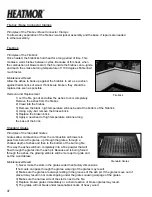
54
ashes
Ash Management and Ash Removal
1)
If ash management is deficient, the HEATMOR™ will not perform to its optimum.
It is time
well spent to ensure proper ash management. In the long run, the operator will be paid back many
times over in higher efficiency and better performance. Improper ash management results in
one unfavorable condition starting a chain reaction of additional problems.
2) Allow
all
wood in the firebox to fully burn out every day or two, and use this opportunity to rake the
ashes in the firebox, down into the grates. By timing the loading of wood so the water
temperature drops to approximately 130 degrees Fahrenheit, means all fuel in the firebox is used up,
and the only thing burning are the ashes. An hour or two of this condition will ensure an easy, smoke
free opportunity to rake the ashes.
When all fuel has been burned out of the ashes, they will be a pale brown color. With a light raking
assistance, they will fall through the grates into the ash pan below. It is best to rake the area
over the grate, every day, such that the grates are at least 25 percent clear of ash. This allows upward
movement of combustion air.
use a LiGht WeiGht, LOnG hanDLeD, sOLiD sPiKeD, raKe tO raKe ashes.
3) If the ashes don’t flow into the ash pan while being raked, the ash pan is possibly full. Removing the
ashes from the ash pan before it is completely full ensures the proper airflow from below the
grates is maintained and also ensures the ashes can drop through the grates into the ash pan.
ashes should be removed before the ash pan is completely full.
4) Be careful not to pull the ashes too close to the front (or the rear) of the firebox, blocking off the
combustion airflow from the air boxes.
5) Do not allow ashes to build up on top of the grates. Air needs to flow through the grates to fuel the
fire. A blocked grate can cause inefficient or non-existent combustion conditions.
6) It is not necessary to rake or move the ashes that accumulate around the sides of the firebox.
Usually they will naturally flow onto the grate area, courtesy of being disturbed as wood is added.
7)
a rule of thumb is to remove ashes once per week.
Choose a certain day of the week and
faithfully do the ash removal chore on that same day, every week.
8) Completely burned ashes will appear like flour. They may be dusty when being removed with the
auger.
a particle mask should be worn when removing ashes with the auger.
9) Obtain a square, steel container, approximately one-bushel in volume that will fit under the ash auger
tube. Auger out the ashes into this square container and
immediately
dispose of them into the larger,
sealed, metal container.
10) Removed ashes should be stored in a
steel
container, sealed with a
steel
tight fitting lid, and
placed in an area free of combustible materials for a few days, to allow the ashes to completely cool
before being disposed.
chaPter 15
















































